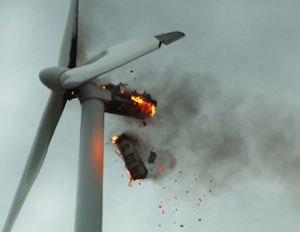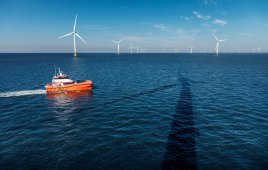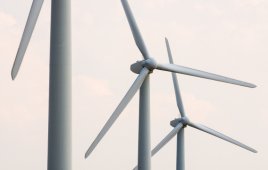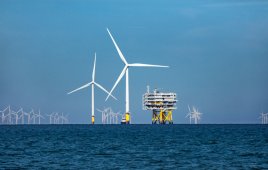
A turbine fire is a fairly rare event but it can cause irreparable damage, making a fire-detection and suppression system an important investment.
The United States Department of Labor, Occupational Safety, and Health Administration recommends the installation of fire detection and control in all wind turbines. However, this is only a suggestion and not yet mandated into law.
“Certainly some municipalities in North America have instated bylaws requiring fire detection and control in industrial wind turbines,” said Mark Johnston, a Renewable Energy Fire-prevention Specialist with Bulldog Turbine Systems. “But there are no set regulations for fire suppression, other than NFPA 850’s recommended practice.”
NFPA 850 is the National Fire Protection Association’s recommended practice for protection of electric generating plants and high-voltage direct current converter stations. Chapter 10 identifies hazards and protections for wind-power facilities.
Without set laws, wind-farm owners must independently develop their own fire-emergency plans. Most wind turbines do not routinely have fire-detection and control systems installed by OEMs because, according to Johnston, this option is simply not ordered or required by the end user.
“Some OEM’s provide a fire extinguisher in the turbine but, in most cases, a technician is responsible for carrying a portable, 2.5-lb extinguisher in their tool bag—along with all of their other safety equipment such as ropes, rigging, and the tools required for the work they’ll perform up-tower,” he said.
He admits that turbine fires are fairly rare events, but when conditions are right, a simple spark can lead to irreparable damage and fatalities. “With such a high cost in term of loss and long shutdowns, you would think every wind farm would contain fire protection and life safety protocols,” said Johnston. “But they don’t.”
Some concerns with installing fire-detection and suppression systems in wind turbines include cost, false alarms, guaranteed fire prevention, electrical equipment damage, and worker and environmental safety.
“We recommend protecting turbines with a cost-effective ‘clean agent’ micro-system that only targets the specific fire hazard. There are devices on the market that are safe for release even while technicians are inside a turbine.”
Traditional detection devices are also worth investing in, such as linear heat-wire, smoke and heat detectors, and air-purification systems. “These systems can be wired through a turbine’s existing SCADA panel, leading to immediate shutdown in a fire and notification,” said Johnston.
“A comprehensive approach with a portfolio of fire-protection devices that guarantee the highest available uptime for a turbine is key,” agreed Heiko Jahr, a communication’s officer with wind developer Siemens.
He said “graduated protection” is preferred. “This means defective system parts are selectively disconnected from the grid. For example, a proper arc-fault-detection system for switchgear will detect a fault and immediately open the medium-voltage circuit breaker on the high-voltage side of the transformer.”
Jahr works in Europe where there are a set of common fire-protection guidelines across the continent that reflect the best practices as developed by the Confederation of Fire Protection Associations.
“Most 130-m high turbines are outside the range of the fire department, and when it comes to fire at sea, human intervention is virtually impossible,” explained Jahr. “That’s why comprehensive fire safety needs to focus on preventive protection to avoid serious losses.”
Bulldog Turbine Systems
http://bulldogturbinesystems.com
Siemens
www.siemens.com
Filed Under: O&M, Safety




I work for a company that is providing systems for fire protection ( detection and suppression) to wind turbines on and offshore since 2004. the main show stoppers for protecting wind turbines is that they are insured against damages through fire. The insurance companies have calculated a loss of 4 wind turbines per year on four insured windfarms. That is the math. So there is no need for fire protection … as long as there is no law, there is no need to install such a system. Secondly there is no regulation especially for wind turbines that cover this kind of protection systems totally (including complete hazid analysis). So even with systems installed still no full protection is ensured nor do approval authorities have the knowledge, skills and personnel to check correct installation on site.